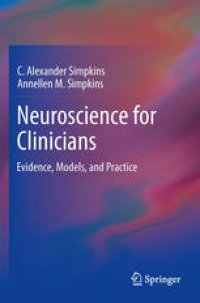
Ebook: Neuroscience for Clinicians: Evidence, Models, and Practice
- Genre: Medicine // Neurology
- Tags: Clinical Psychology, Neurosciences, Cognitive Psychology, Neuropsychology
- Year: 2013
- Publisher: Springer-Verlag New York
- Edition: 1
- Language: English
- pdf
This book fills the need for an introductory text that opens the field up to the beginner and takes them to higher-level thinking about neuroscience. Neuroscience has captured the interest of students, professionals, and the general public. In fact it is so new, that there are very few books that gather it together in one text. Neuroscience is an amalgamation of many fields: psychology, cognitive science, chemistry, biology, engineering, philosophy, mathematics, and statistics. People who are new to the discipline have to be able to find their way through all of these fields together. In addition, they need to understand the highly technical lexicon, modeling methods, and theoretical assumptions used to describe brain structure, function, and the interaction between them. This book helps readers navigate the conventions used to describe the brain that developed through the years. The authors crystallize the complex modeling methods and technologies so that readers understand what they are saying and how to use them. They address the important underlying principles and important issues of neuroscience, with the debates and discussions that are ongoing as the field evolves. They also include many salient fine-grained details so that the book is not just an overview, but also a useful guide for many levels of readers.
Neuroscience for Clinicians: Evidence, Models, and Practice
C. Alexander Simpkins and Annellen M. Simpkins
Psychology began as the study of thoughts, moods, and emotions—the realm of the mind—gradually adding findings from neuroscience about the workings of the brain. Current interest in mind-body health and in the biological underpinnings of mental illness is creating new opportunities for therapists to bring brain and mind together in the treatment room.
Neuroscience for Clinicians introduces an elegant new lens not only for understanding the role of the brain in pathology, but also for using this knowledge in therapy, to help the mind by treating the brain. Offering conceptual models and empirical data as well as hands-on techniques and practical guidelines, it describes methods versatile enough to be used by therapists across theoretical orientations. Detailed discussion of neuroplasticity explores the brain’s capacity for change and in-depth case studies of anxiety, substance abuse, cognitive problems, and mood disorders demonstrate the mind’s ability to alter brain structures during the course of therapy. And the book is written at a comfort level that requires no previous neuroscience background. Featured in the coverage:
- Learning from brain-damaged individuals.
- How neurons think and learn.
- Neuroplasticity and neurogenesis: moment-by-moment change.
- Incorporating the brain into treatment.
- Maximizing the social brain.
- Shifting the nervous system in common disorders.
Clinicians interested in understanding the brain’s interactions with the mind and its role in psychological problems will find Neuroscience for Clinicians stimulating and adaptable to their own approaches to therapy. The book can also enhance neuroscience and biological psychology classes in cognitive science, medical, and psychology departments.